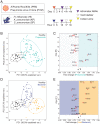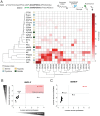Host protease activity classifies pneumonia etiology
- PMID: 35696579
- PMCID: PMC9231472
- DOI: 10.1073/pnas.2121778119
Host protease activity classifies pneumonia etiology
Abstract
Community-acquired pneumonia (CAP) has been brought to the forefront of global health priorities due to the COVID-19 pandemic. However, classification of viral versus bacterial pneumonia etiology remains a significant clinical challenge. To this end, we have engineered a panel of activity-based nanosensors that detect the dysregulated activity of pulmonary host proteases implicated in the response to pneumonia-causing pathogens and produce a urinary readout of disease. The nanosensor targets were selected based on a human protease transcriptomic signature for pneumonia etiology generated from 33 unique publicly available study cohorts. Five mouse models of bacterial or viral CAP were developed to assess the ability of the nanosensors to produce etiology-specific urinary signatures. Machine learning algorithms were used to train diagnostic classifiers that could distinguish infected mice from healthy controls and differentiate those with bacterial versus viral pneumonia with high accuracy. This proof-of-concept diagnostic approach demonstrates a way to distinguish pneumonia etiology based solely on the host proteolytic response to infection.
Keywords: bacterial infections; diagnostics; nanoparticles; pneumonia; viral infections.
Conflict of interest statement
Competing interest statement: S.N.B. reports compensation for cofounding, consulting, and/or board membership in Glympse Bio, Satellite Bio, CEND Therapeutics, Xilio Therapeutics, Catalio Capital, Intergalactic Therapeutics, Port Therapeutics, Vertex Pharmaceuticals, Danaher, and Moderna and receives sponsored research funding from Johnson & Johnson, Revitope, and Owlstone Medical.
Figures






Similar articles
-
Predicting the microbial cause of community-acquired pneumonia: can physicians or a data-driven method differentiate viral from bacterial pneumonia at patient presentation?BMC Pulm Med. 2020 Mar 6;20(1):62. doi: 10.1186/s12890-020-1089-y. BMC Pulm Med. 2020. PMID: 32143620 Free PMC article.
-
Protease activity sensors noninvasively classify bacterial infections and antibiotic responses.EBioMedicine. 2018 Dec;38:248-256. doi: 10.1016/j.ebiom.2018.11.031. Epub 2018 Nov 29. EBioMedicine. 2018. PMID: 30503861 Free PMC article.
-
Predictive signature of murine and human host response to typical and atypical pneumonia.BMJ Open Respir Res. 2024 Aug 3;11(1):e002001. doi: 10.1136/bmjresp-2023-002001. BMJ Open Respir Res. 2024. PMID: 39097412 Free PMC article.
-
The role of atypical pathogens in community-acquired pneumonia.Semin Respir Crit Care Med. 2012 Jun;33(3):244-56. doi: 10.1055/s-0032-1315636. Epub 2012 Jun 20. Semin Respir Crit Care Med. 2012. PMID: 22718210 Review.
-
The Microbial Etiology of Community-Acquired Pneumonia in Adults: from Classical Bacteriology to Host Transcriptional Signatures.Clin Microbiol Rev. 2022 Dec 21;35(4):e0001522. doi: 10.1128/cmr.00015-22. Epub 2022 Sep 27. Clin Microbiol Rev. 2022. PMID: 36165783 Free PMC article. Review.
Cited by
-
Protease Activity Analysis: A Toolkit for Analyzing Enzyme Activity Data.ACS Omega. 2022 Jul 6;7(28):24292-24301. doi: 10.1021/acsomega.2c01559. eCollection 2022 Jul 19. ACS Omega. 2022. PMID: 35874224 Free PMC article.
-
Conformationally Locked Peptide-DNA Nanostructures for CRISPR-Amplified Activity-Based Sensing.Angew Chem Int Ed Engl. 2025 Jun 17;64(25):e202500649. doi: 10.1002/anie.202500649. Epub 2025 Apr 30. Angew Chem Int Ed Engl. 2025. PMID: 40222963 Free PMC article.
-
A 5-transcript signature for discriminating viral and bacterial etiology in pediatric pneumonia.iScience. 2025 Jan 4;28(2):111747. doi: 10.1016/j.isci.2025.111747. eCollection 2025 Feb 21. iScience. 2025. PMID: 39906557 Free PMC article.
-
Review: Diagnostic Potential for Collaborative Pharyngitis Biomarkers.J Infect Dis. 2024 Oct 23;230(Supplement_3):S190-S196. doi: 10.1093/infdis/jiae416. J Infect Dis. 2024. PMID: 39441193 Free PMC article. Review.
-
A breath-based in vitro diagnostic assay for the detection of lower respiratory tract infections.PNAS Nexus. 2024 Sep 24;3(9):pgae350. doi: 10.1093/pnasnexus/pgae350. eCollection 2024 Sep. PNAS Nexus. 2024. PMID: 39319329 Free PMC article.
References
-
- Jones B. E., et al. , Summary for clinicians. Ann. Am. Thorac. Soc. 17, 133–138 (2020). - PubMed
Publication types
MeSH terms
Substances
Grants and funding
LinkOut - more resources
Full Text Sources
Medical
Molecular Biology Databases
Miscellaneous

